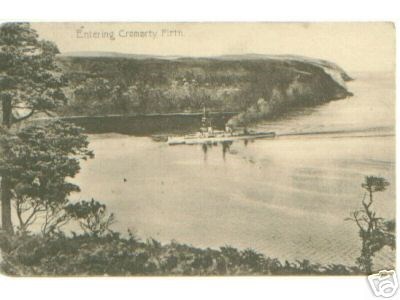
Warship Entering Cromarty Firth
This is from an old postcard of about 1910 on what would apear to be a very calm day.
Albums: Landscapes and Views, Postcards, The Sea
3 Comments
Another nice shot - sadly not HMS Bellerophon, however, as she had two masts, one immediately in front of each of her 1st and 2nd funnels, with no mainmast further aft.
I suspect this is HMS Neptune.
This ship has plenty of room for a main turret between the two funnels, and room for another one between the 2nd funnel and the mainmast which can be seen further aft, partly obscured by smoke.
Neptune had a single turret fwd, a single turret offset to port between the two funnels (so visible in this shot), a single turret offset to strbrd between the 2nd funnel & the mainmast (so less visible from this angle) and a pair of superfiring turrets aft of her mainmast.
As with all the modern heavy ships, she received significant and continuous modifications throughout her career.
A more detailed scan of this photo might enable both her identity to be confirmed, and a reasonably accurate date range to be established.
Comment left on 16 July 2007 at 23:52 by Jon Summers (London)
I suspect this is HMS Neptune.
This ship has plenty of room for a main turret between the two funnels, and room for another one between the 2nd funnel and the mainmast which can be seen further aft, partly obscured by smoke.
Neptune had a single turret fwd, a single turret offset to port between the two funnels (so visible in this shot), a single turret offset to strbrd between the 2nd funnel & the mainmast (so less visible from this angle) and a pair of superfiring turrets aft of her mainmast.
As with all the modern heavy ships, she received significant and continuous modifications throughout her career.
A more detailed scan of this photo might enable both her identity to be confirmed, and a reasonably accurate date range to be established.
Comment left on 16 July 2007 at 23:52 by Jon Summers (London)
I don't think this ship is HMS Bellerophon or HMS Neptune. The reflection in the water suggests that the mainmast IS forward of the rear funnel but it does not show against the dark water behind. The dark object aft of the rear funnel shows a short reflection and is therefore most likely to be the aft island searchlight structure. If you enlarge the photo, the rear funnel appears to be much larger front to back, which would identify the ship as perhaps from the class following the Bellerophon class, probably HMS Vanguard, which exploded on 9th July 1917 in Scapa flow with the loss of all but two of her crew. The other two ships of the class had white funnel bands, Vanguard had a red band on the rear funnel which the photo appears to show when enlarged. The built-up bridgework would suggest a date reasonably near to the start of World War I .... but I could be wrong!!
Comment left on 24 April 2008 at 20:00 by Campbell Ross
Form Goes Here
HMS Bellerophon was built at Portsmouth Dockyard and a veteran of the Battle of Jutland. She was scrapped in 1923.
Displacement: 18, 800 tons. Speed: 21 knots. Armament: Ten 12 inch guns in pairs, sixteen 4 inch quickfiring guns, four 3pdr guns, three 18 inch guns and 3 torpedo tubes. Compliment: 733
Comment left on 19 November 2004 at 18:29 by Andrew Bathie